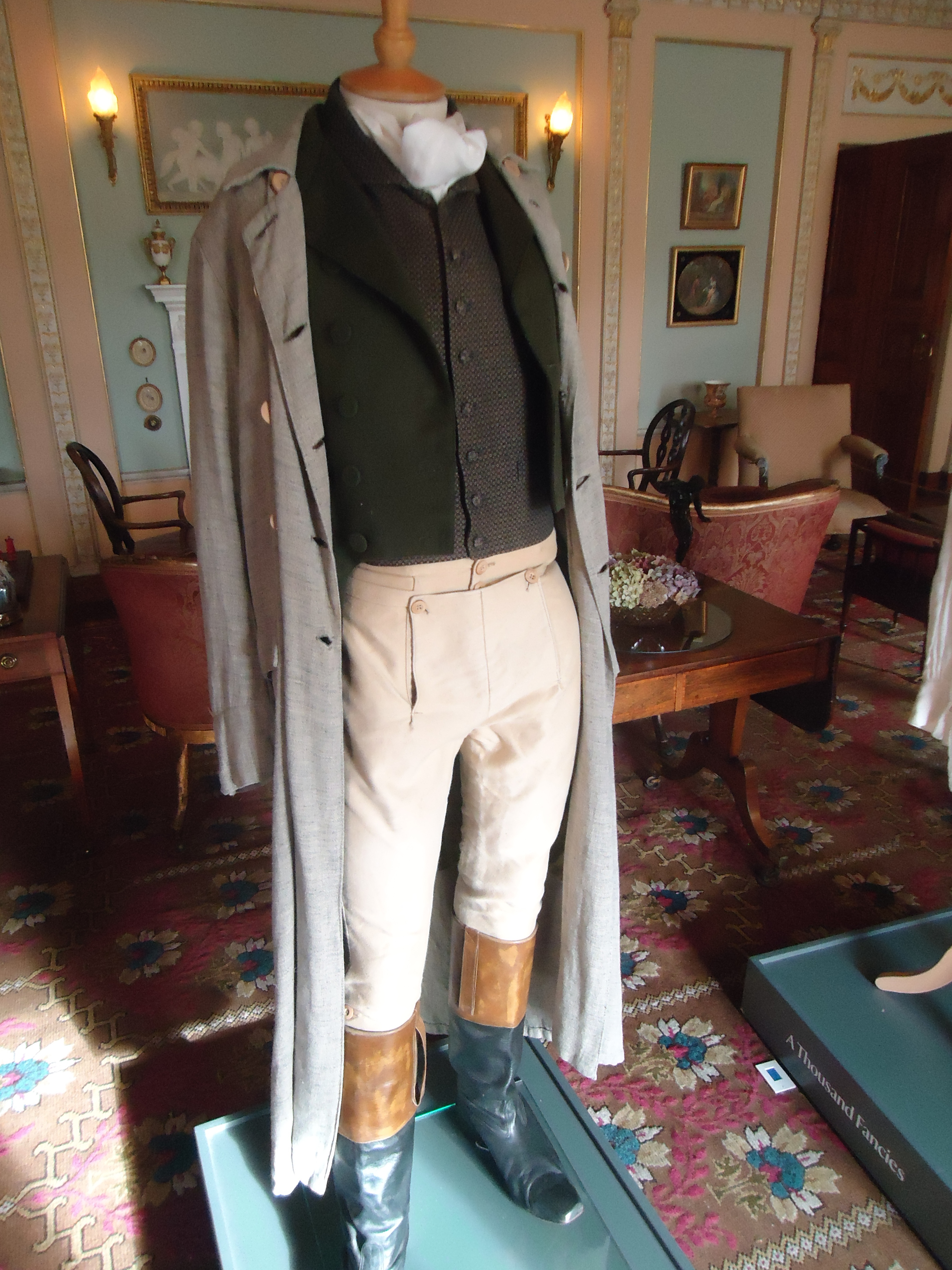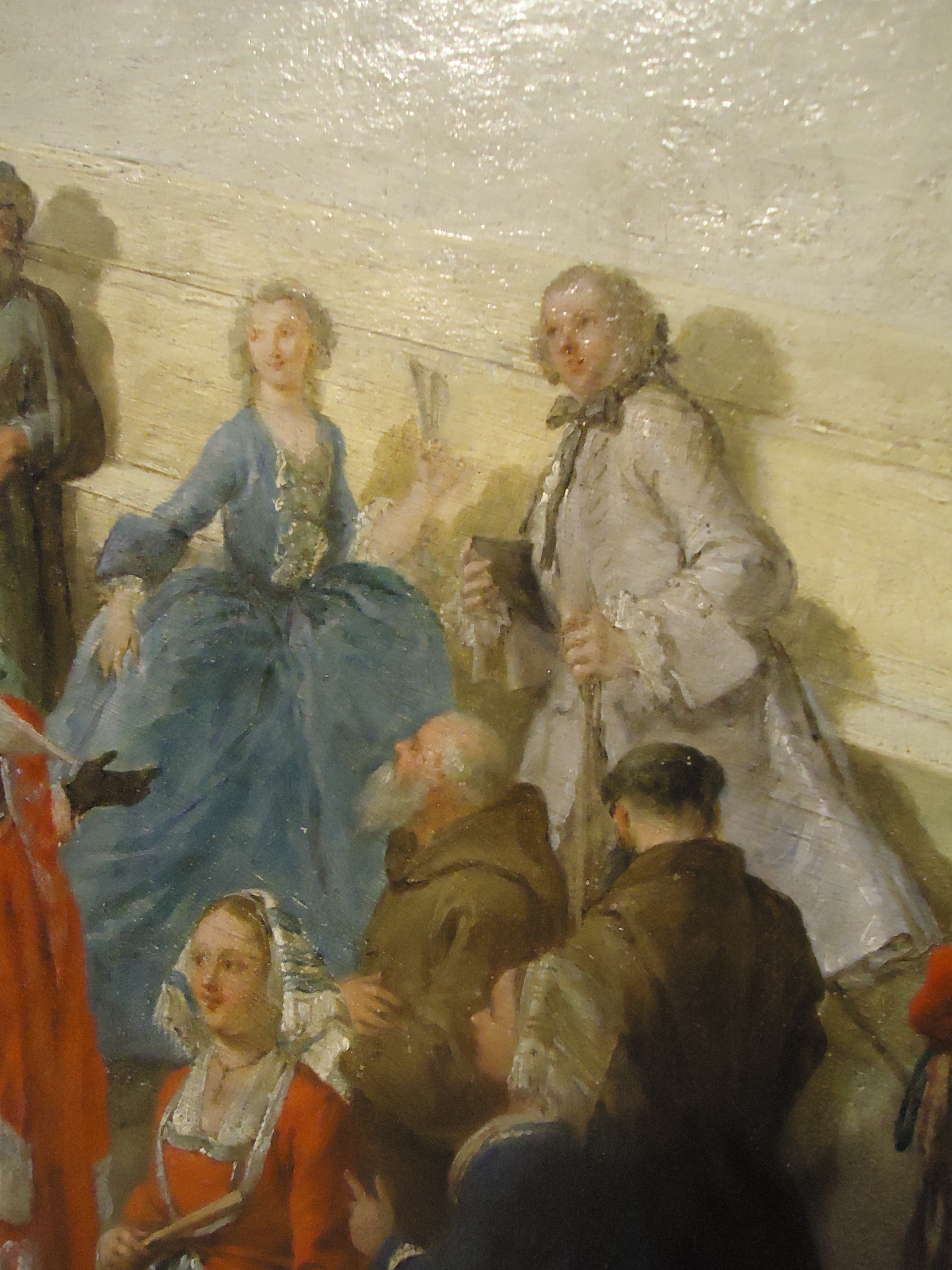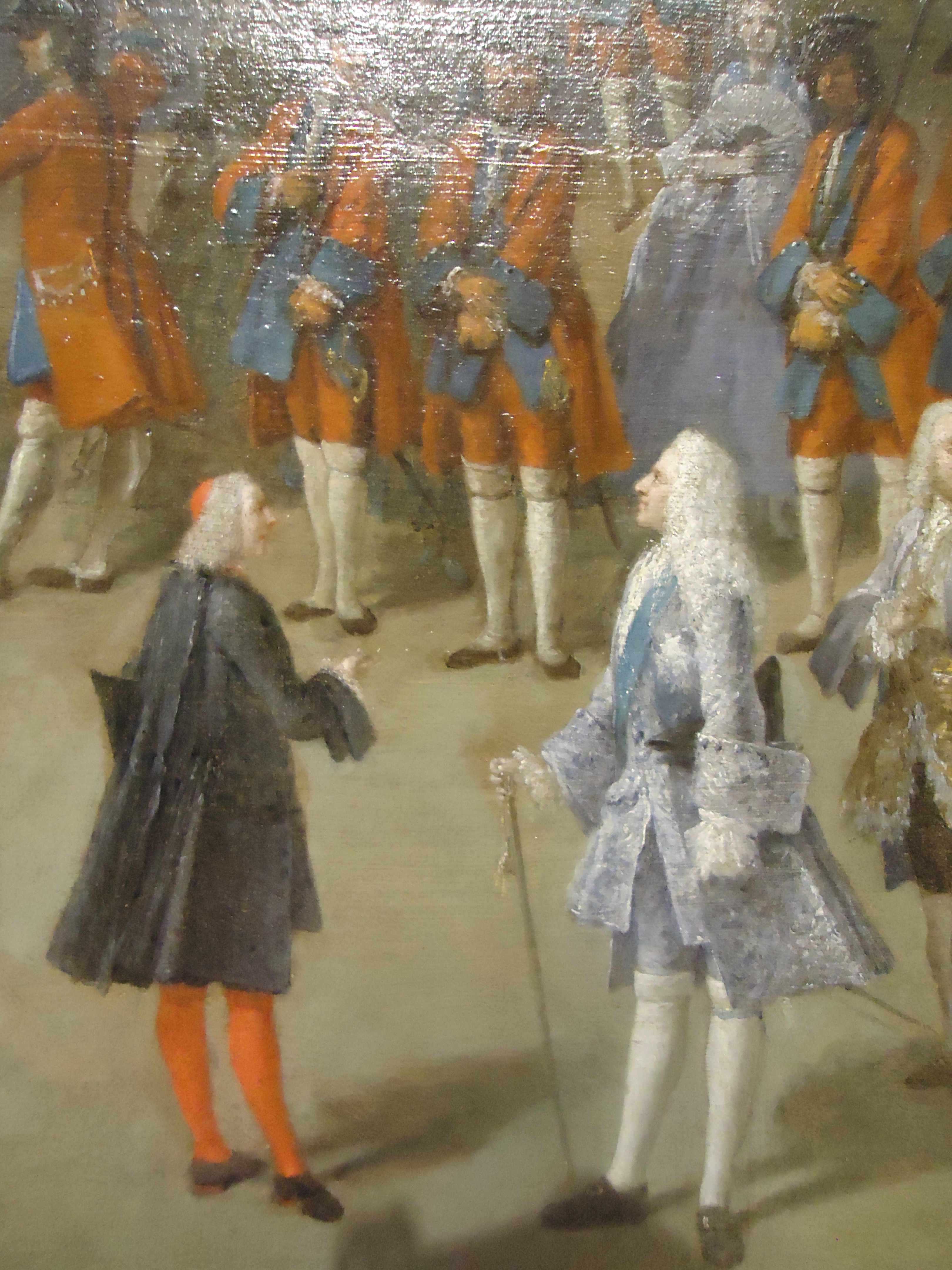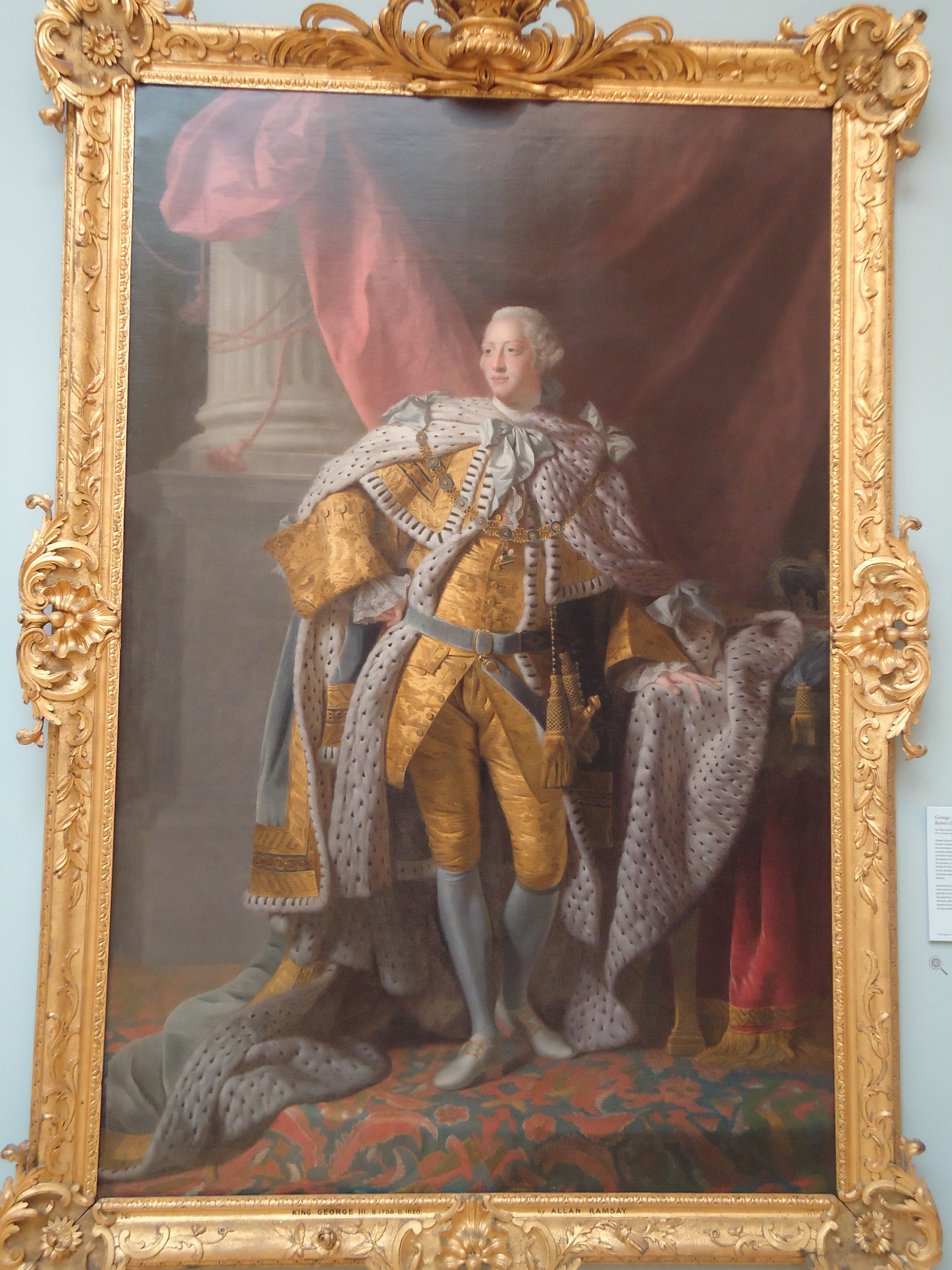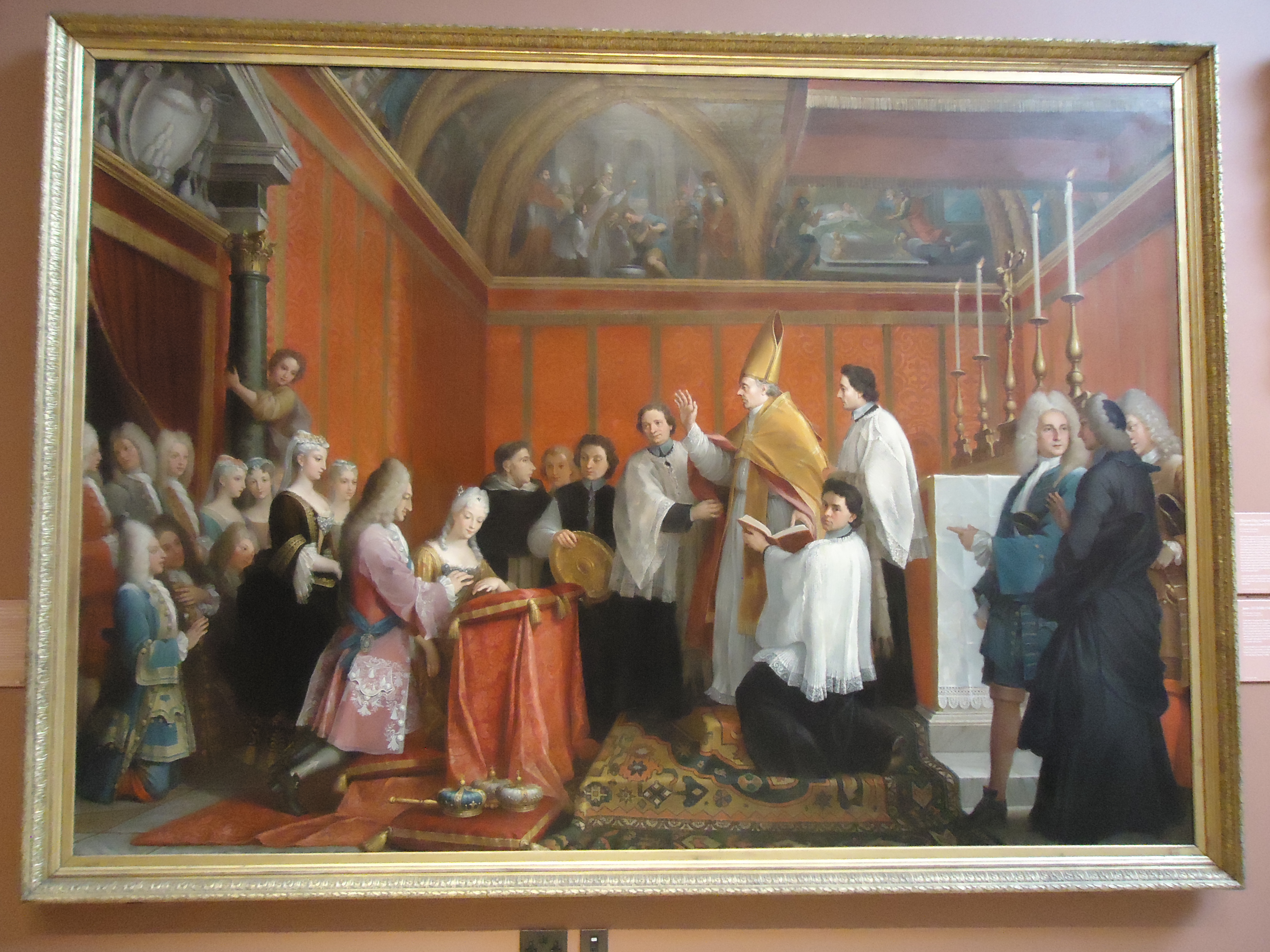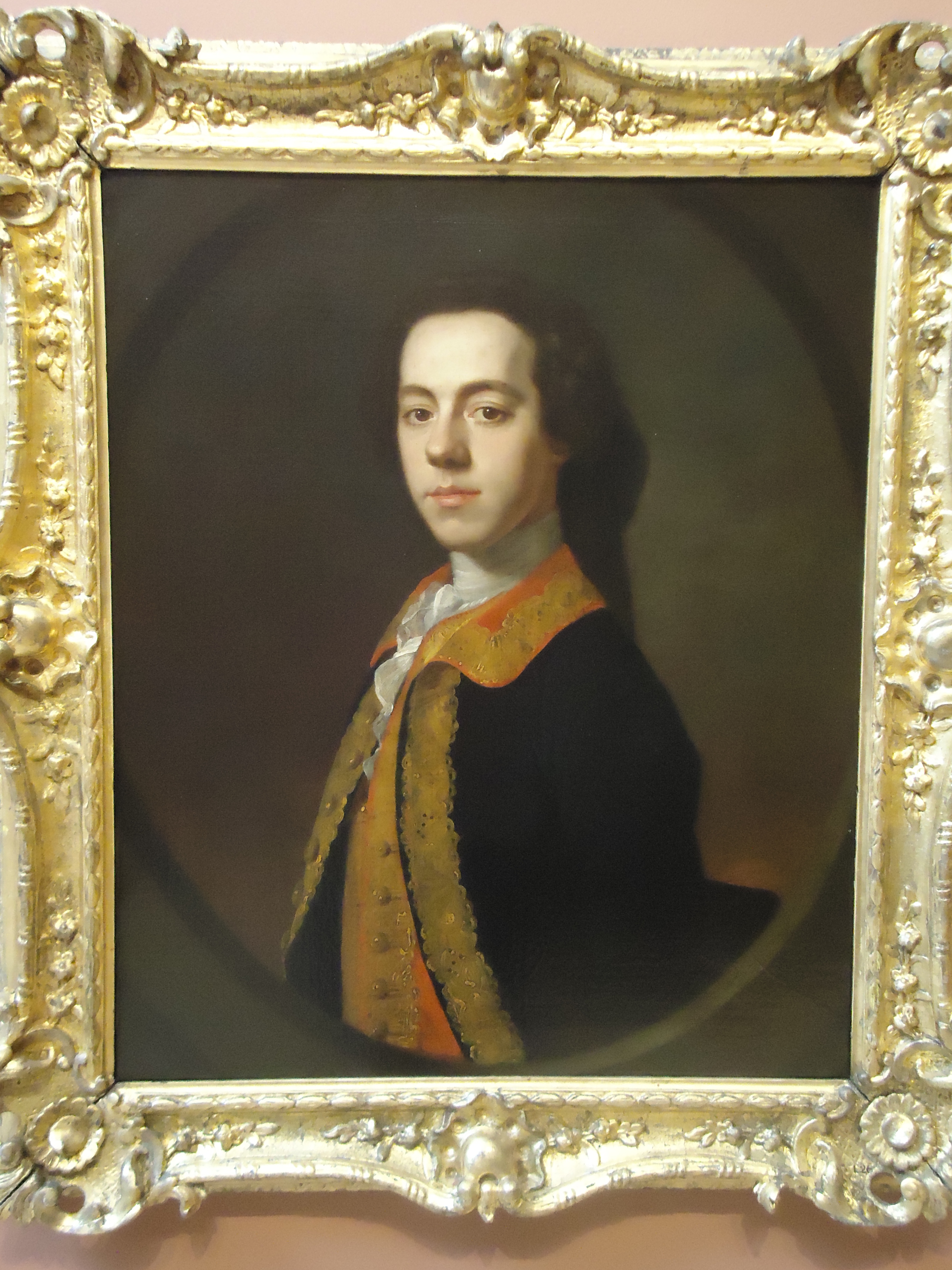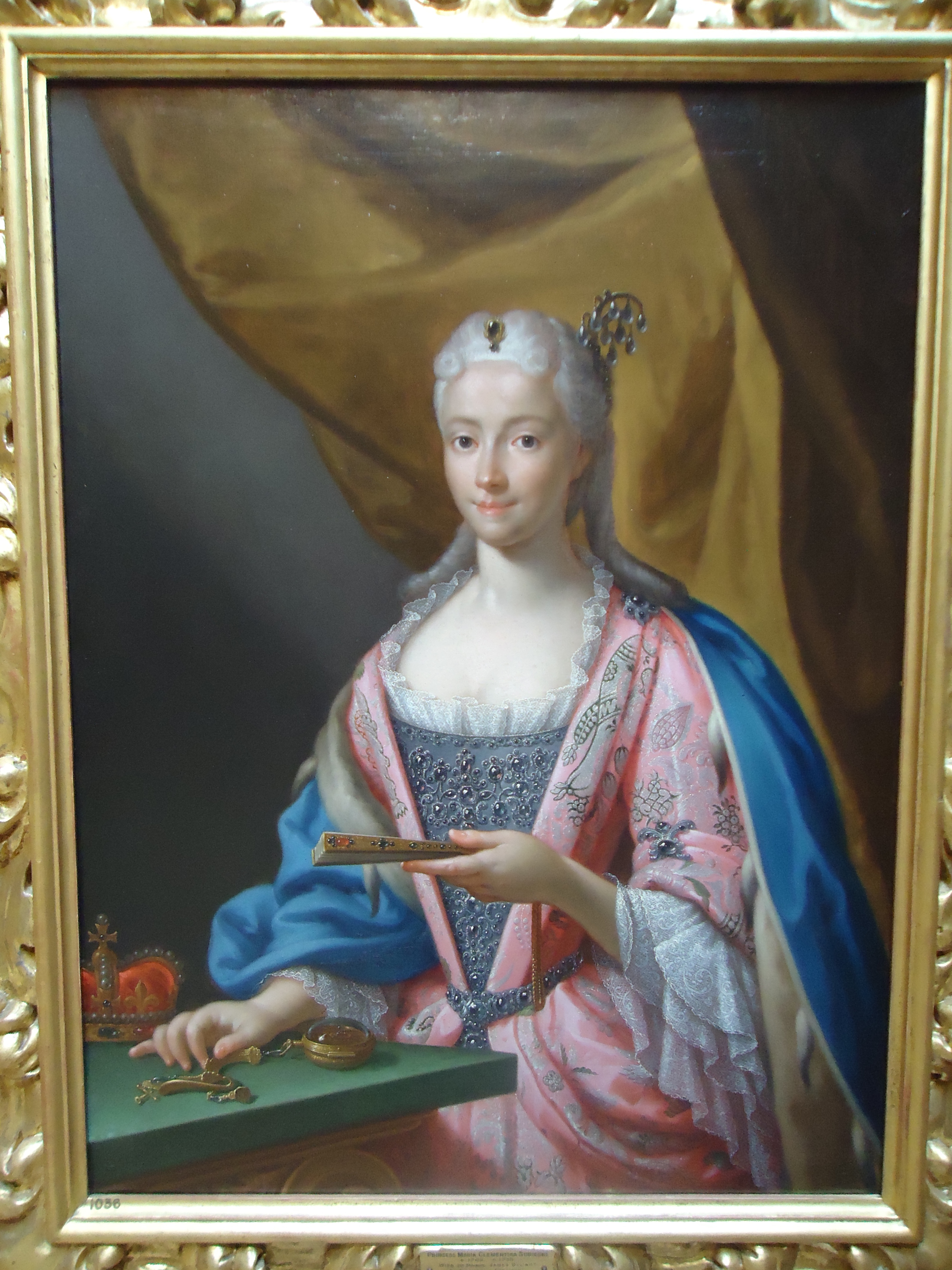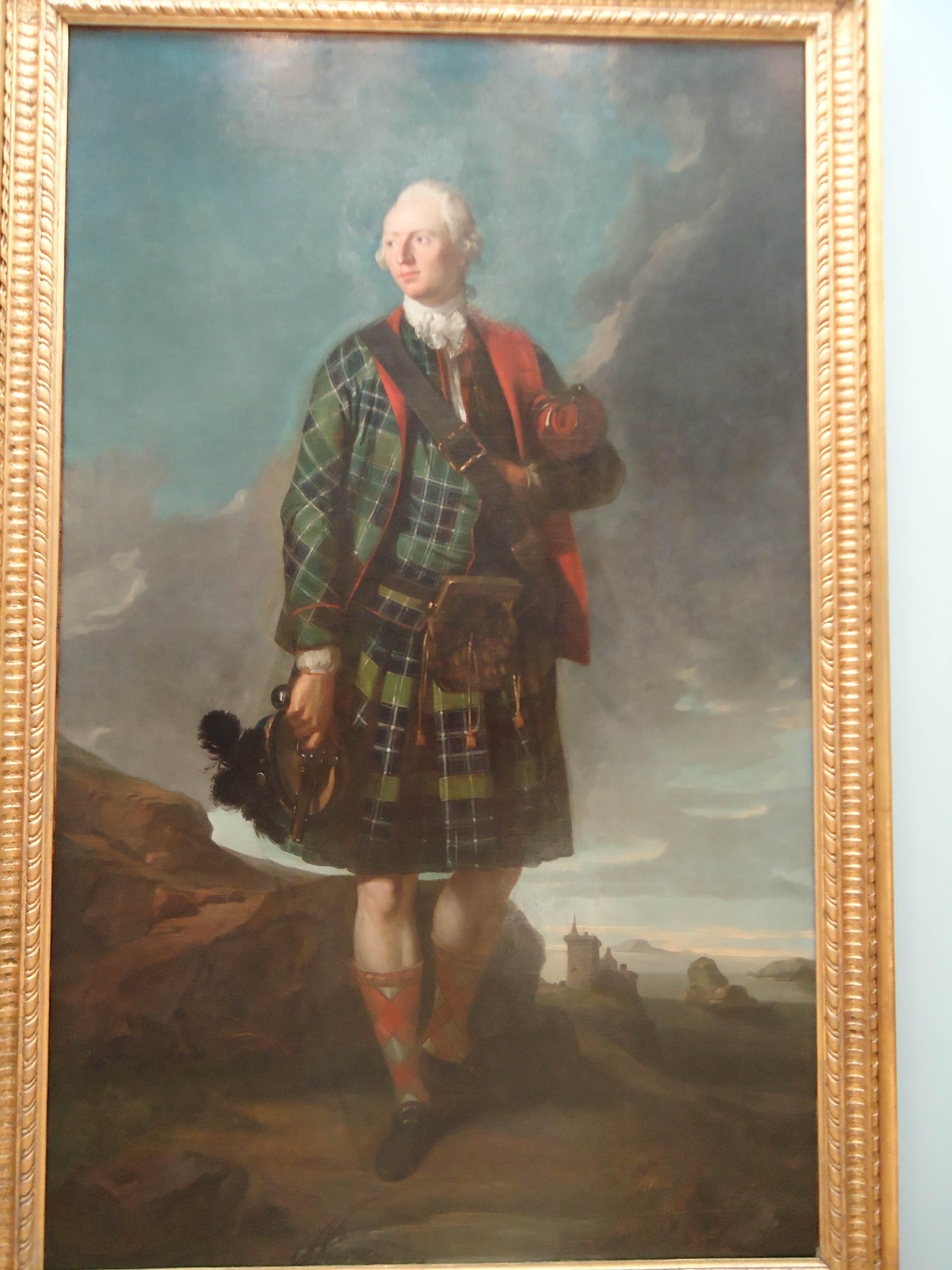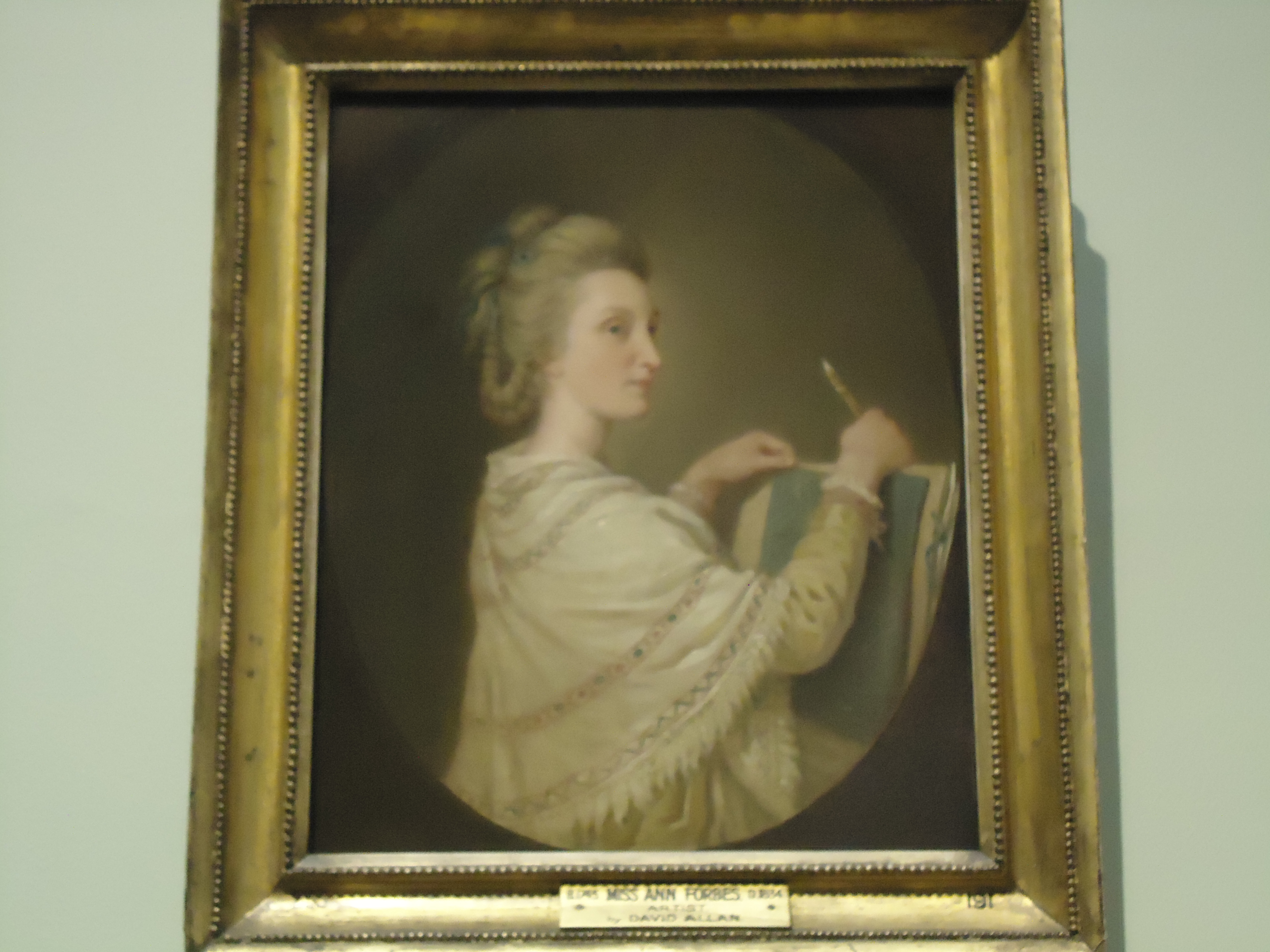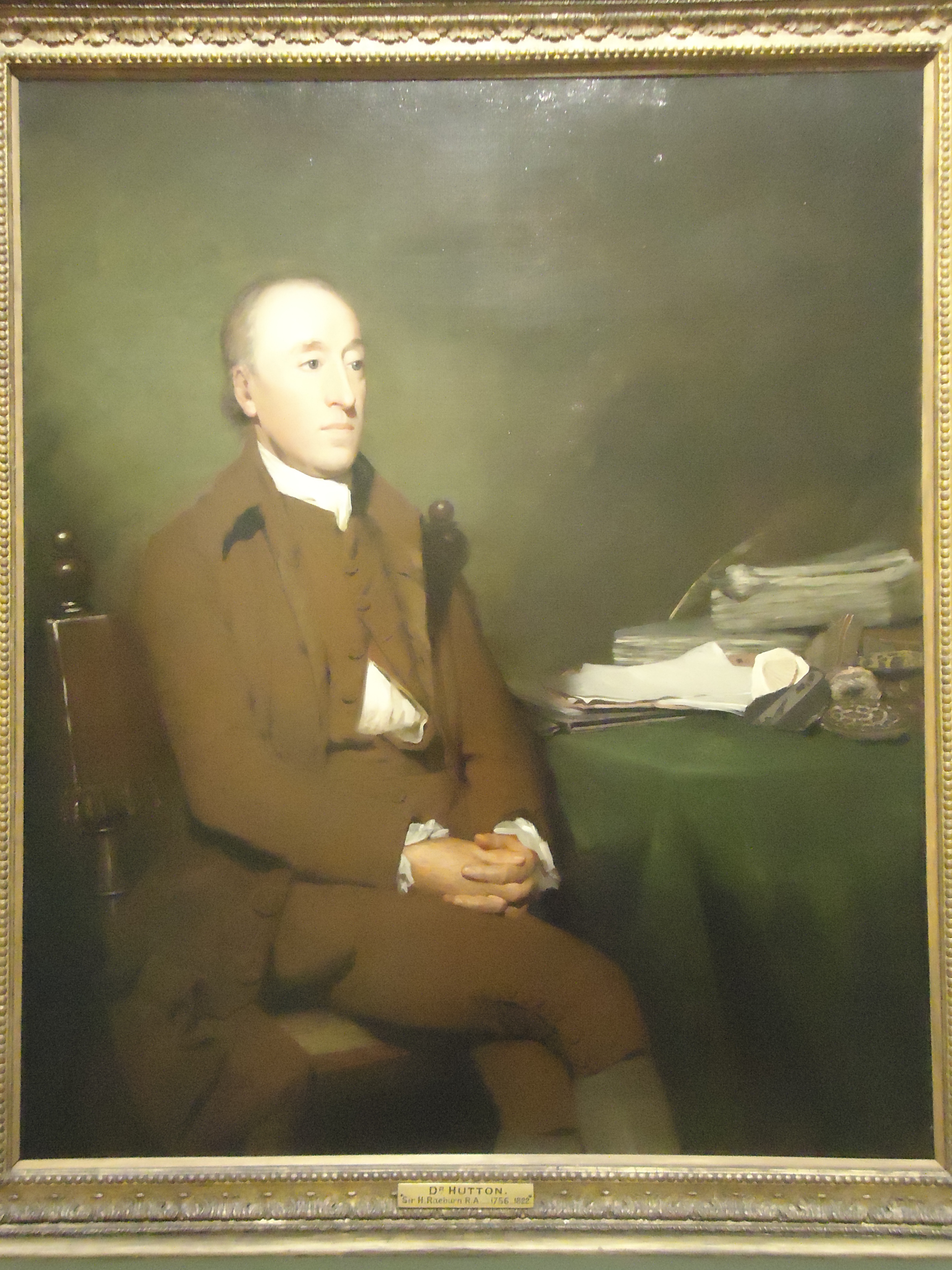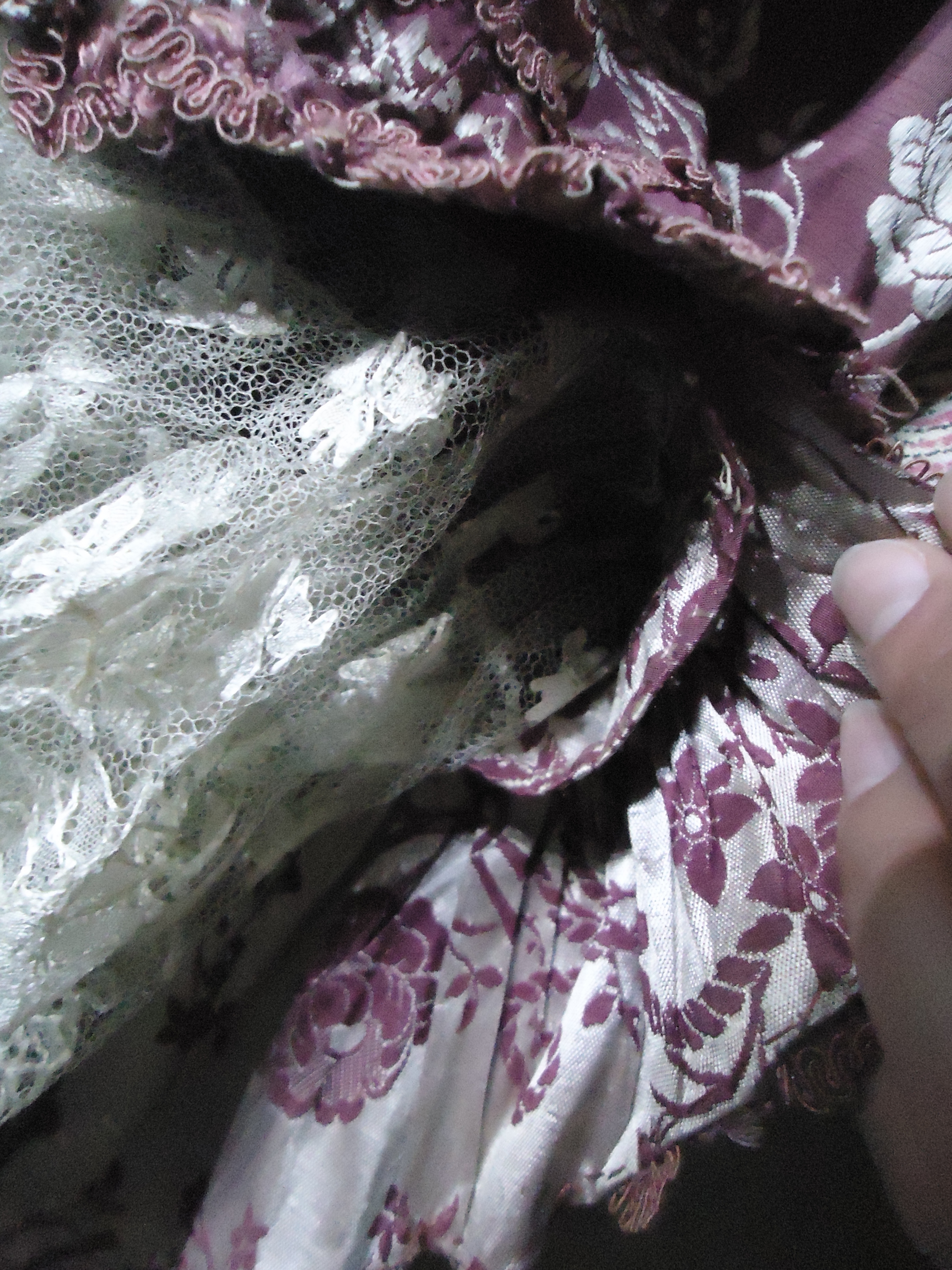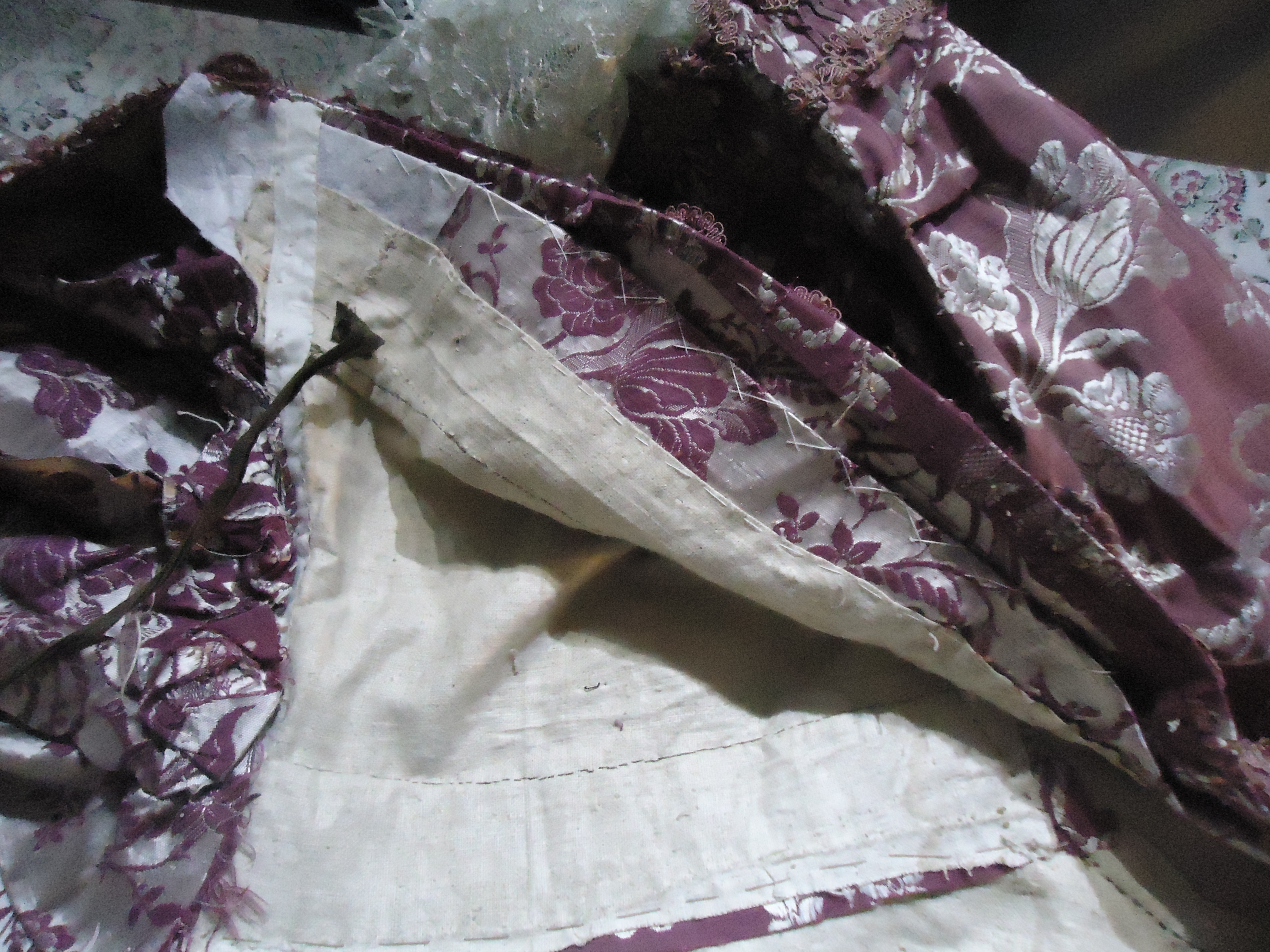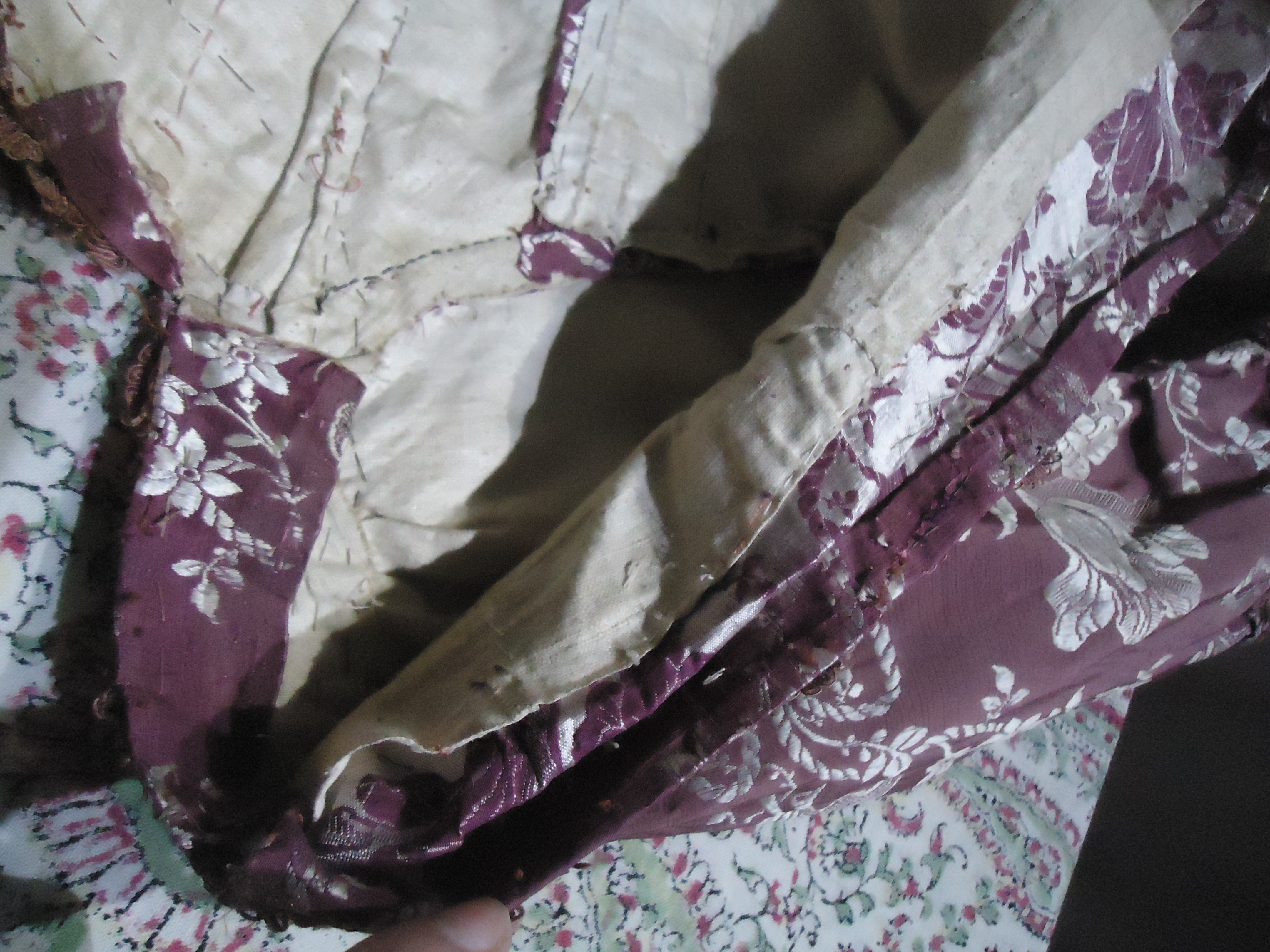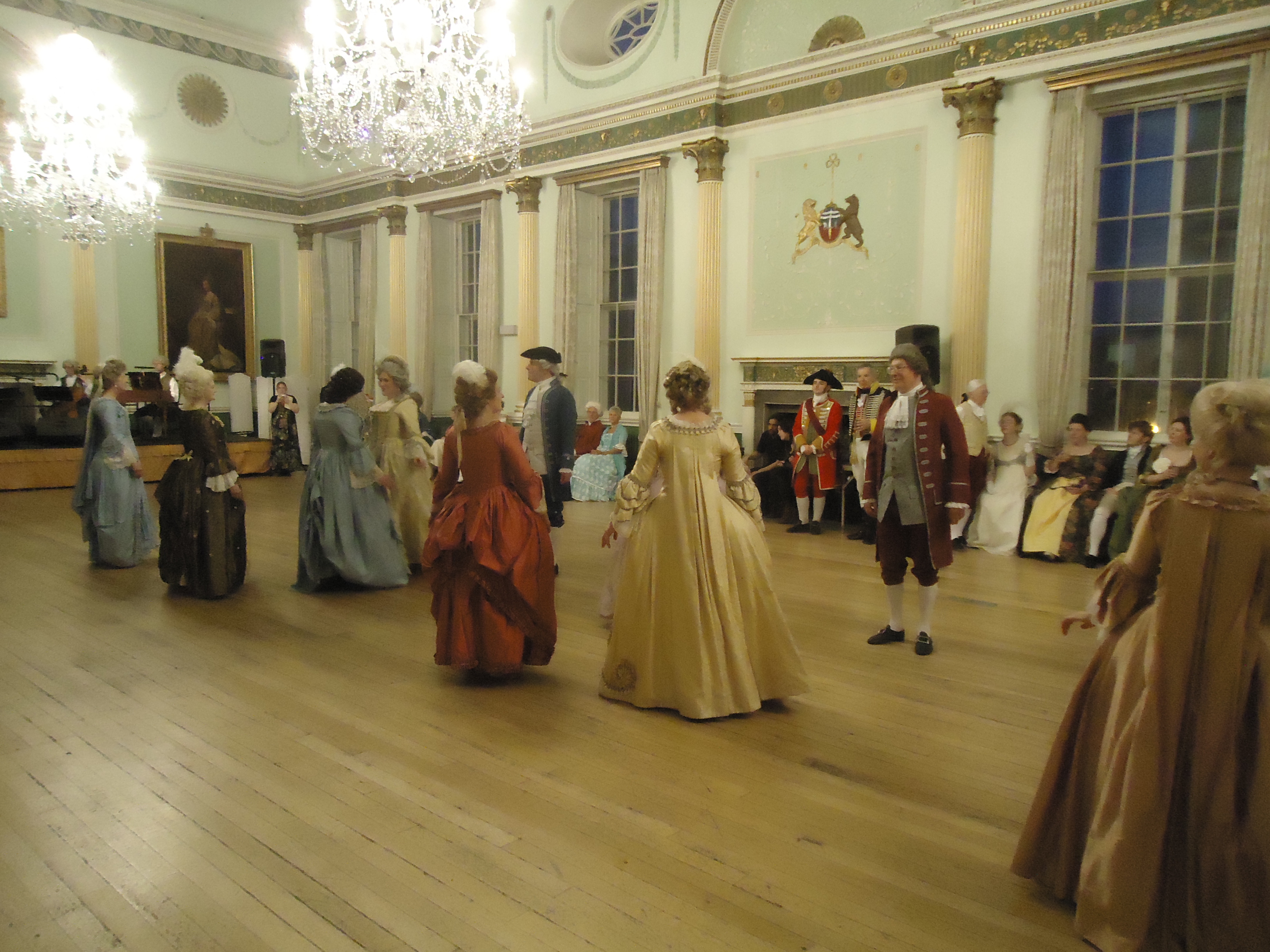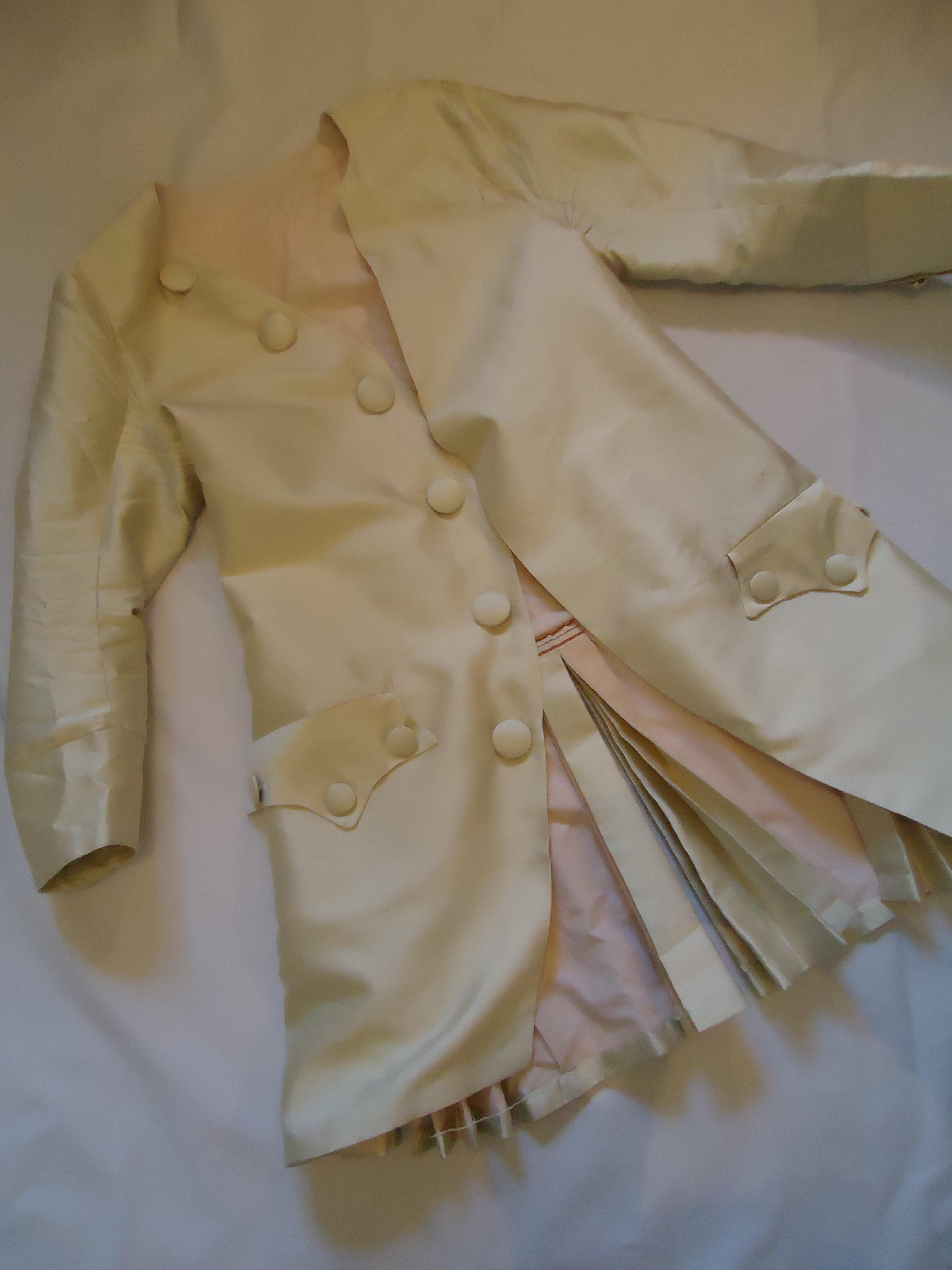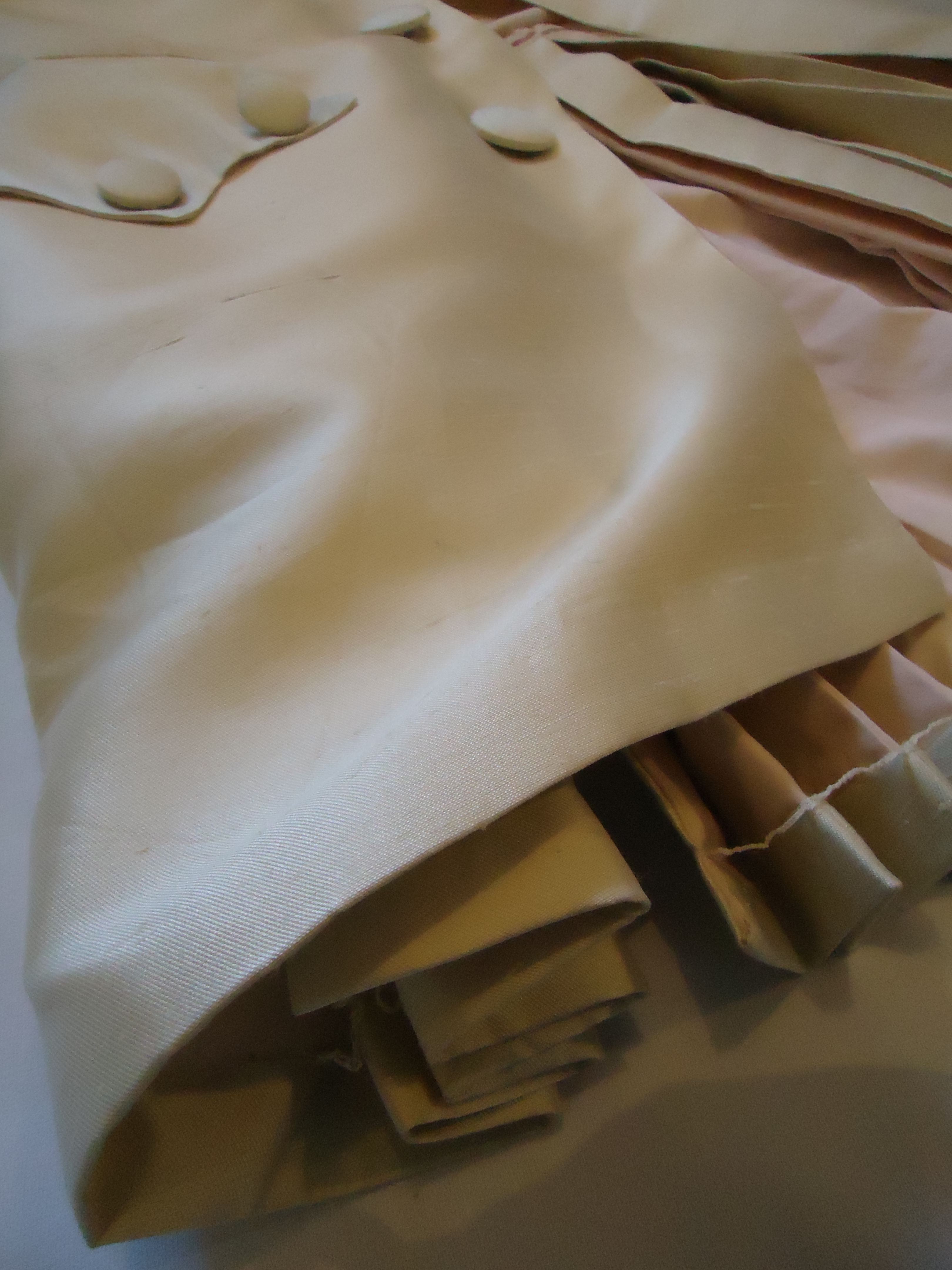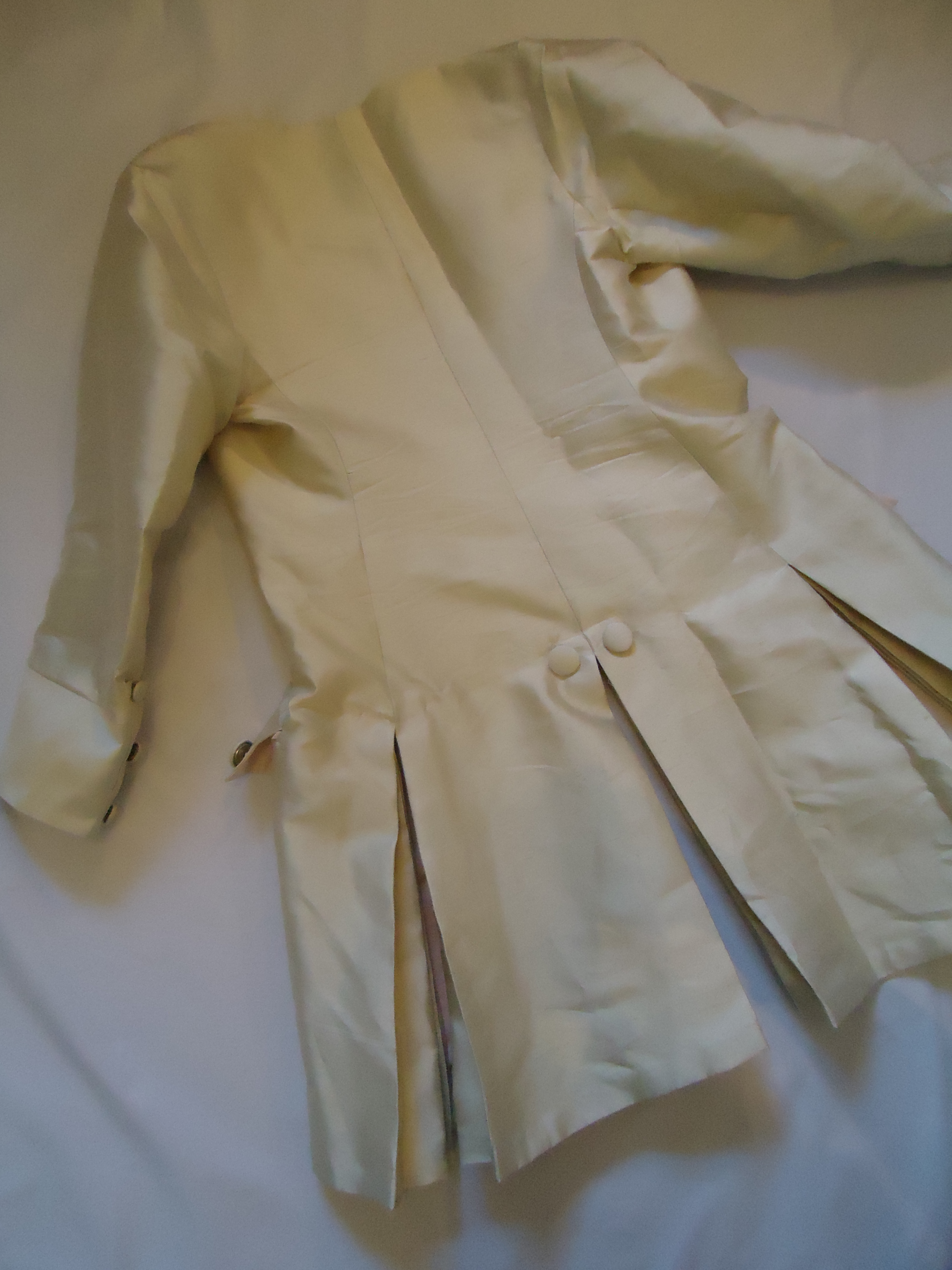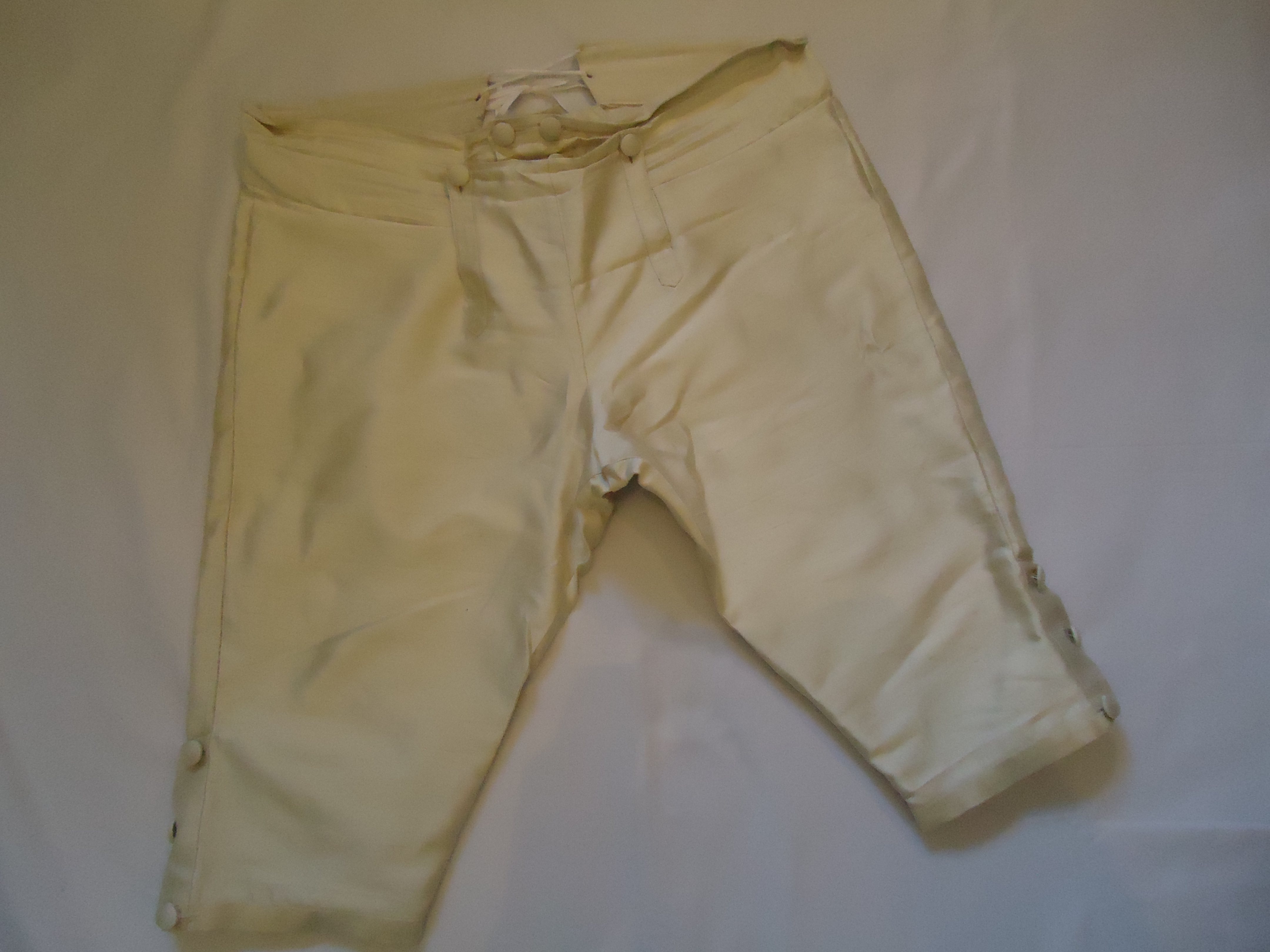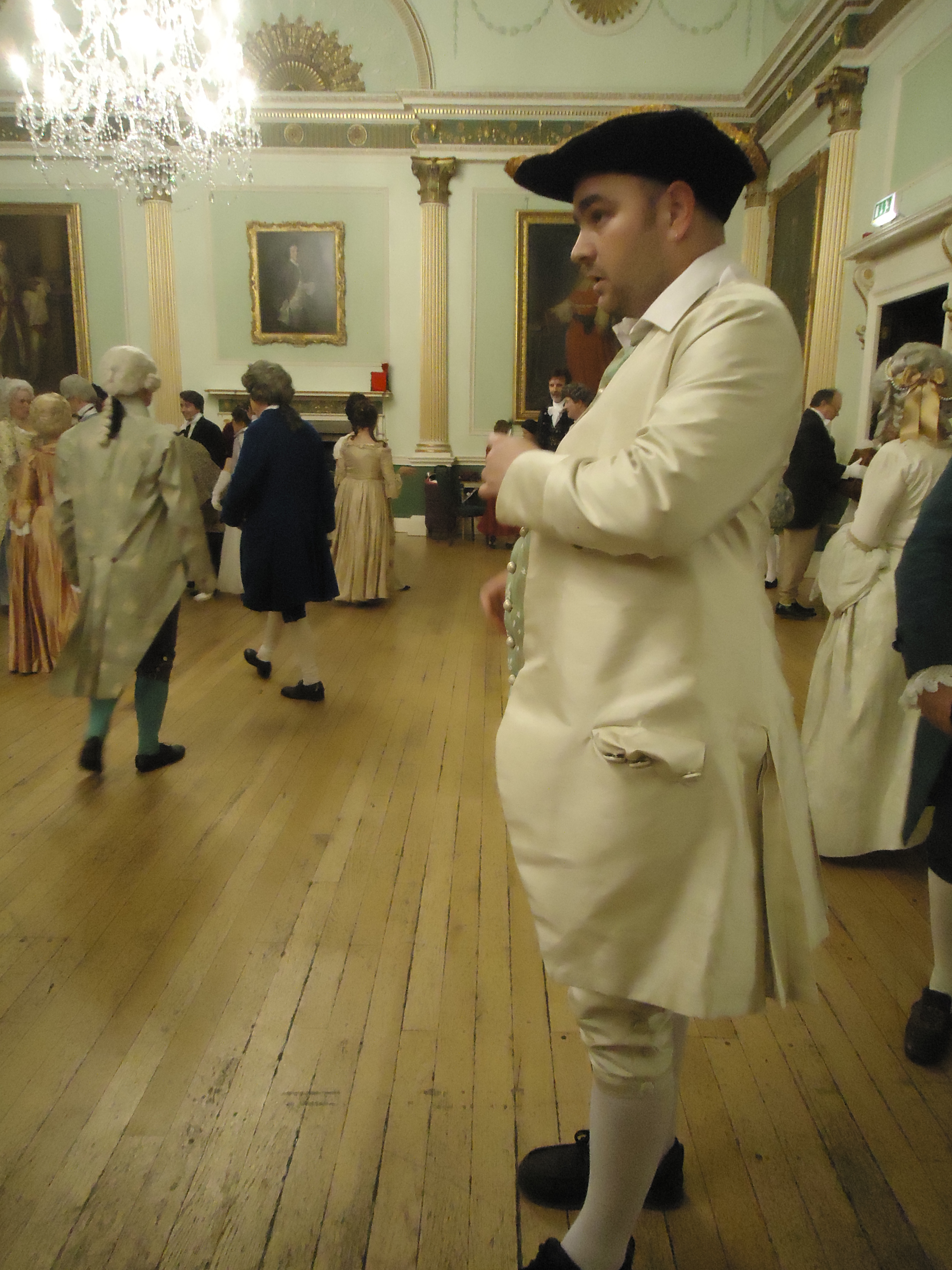A Study of a Painting:
James III and his Son Henry Benedict - Monaldi, Pubalacci and 'Silvestri' - July 1747
Hanging in the National Portrait Gallery in Edinburgh, spanning a massive part of the wall is this incredible painting. The crowds in the background contain people from all walks of life: monks, soldiers, normal people looking on, the fashionable, the elite and the poor. It has people hanging out of windows, walking through the corridors and all in all containing some interesting costume details from the period.

The Painting depicts the meeting of James III (The old Pretender) and his second son Henry Benedict, celebrating his becoming the Cardinal Deacon. It is a massive painting and easy to just stand in front of and simply oggle.
- To our modern eye it seems strange that James III and Henry Benedict (who declared himself HenryIX in 1788 after his brother died) don't stand out more in the painting, neither their costume nor their size marks them out. I had trouble spotting them, even with the description supplied by the Musuem, as they are neither central nor clearer than those surrounding them. I admit that I am no Art Historian and certainly lack the very specific knowledge of being able to read a painting, but it is possible that the King and his son's apparent nondescript nature was purposeful. The plight of James III (The Old Pretender) and his sons was not always supported and could've been seen as weak and a bit of an embarrassment and hence the strangeness of the crowd and the seemingly undemanding state of these two important figures. We know, for example that Henry Benedict felt embarrassed when sent by his older Brother (Bonnie Prince Charlie) to France to drum up support and finances so it could be that the largeness of the building and some of the indifference of the crowd is reflecting this issue.
Close up Details:
Painted outside the Stuarts Palace in Rome, this painting appears to show close up features of both general European fashion (based on English and French fashions) and also particular local fashion popular in Rome.
Image no.1
Details of the above:
- The striped nature and tassled design of them suggests that this style of head dress be perhaps distinct to Italian trends and we've certainly not come across this look in English portraiture.
- Crosses were also, very rarely seen in English fashion as a form of neckwear for this period.
- These ladies jackets have a military style to them, not a far cry from our Riding habits and the front lady seems to have a long pocket opening in her skirt. This, though, could be just an attempt at painting a crease in the skirt that sits slightly wrong.
- They also have their neck cloths tucked in differently to what is normally seen in English paintings.
- Their skirts appear to have braiding trimmed on the edge and as decoration.
Image no.2
Details of the Above:
- The Pale Blue lady in the centre of this image is wearing a large side-hooped dress. Although it is unclear if she is sporting a Robe a l'Anglais or a Robe a la Francais, it does seem to be quite generously gathered at the CF. This style of skirt fades out of popularity in English and French fashions the further you get into the eighteenth century and is beginning to be less seen at this time, possibly a little earlier than this even if we're honest. There are many images of ladies with full fronted skirts in around the 1730's - 40's and feature quite highly in Hogarth's paintings.
- She also has a large Separate Cuff Sleeve which again was popular about this time but this too begins to drop from fashionable about this date.
- Her friend with his grey suit is a lovely example of what was fashionable in men's clothing for this date. His large black bow at his neck, his gathered lace ruffle and wide, almost held out Coat skirts are all prime examples of men's clothing and he ties in very closely with some of Hogarth's drawings for this period. What we've done is we've created a page especially for this Study that shows the examples of Full Skirted dresses and the Men's coats Painted by Hogarth. This can be used as Comparison Aid to see what was being depicted in English Fashion at about the same time and be able to get a better view of 1740's fashion. Please click on this link here:
Hogarth: A Comparison Aid.

Image no.3
Details:
- Considering that this lady in the above image, and those around her are just background characters, it's incredible at how much detail the artists have painted them with. We have a complete question mark over the man in green standing next to her, with his hair looking as if it's tied up in bun and his green clothing (perhaps if any of you out there are studying specific Italian local costume you might be able to help us here) which means we can't do much but just point him out to you.
- But the lady and her child are a bit more easy to define. She wears a long brown petticoat with a vague lighter colour Sleeved bodice/jacket/dress as the top section. the very full white section that is draped around her and tucked up could well be an apron. This fashion of draping either the top skirt or the apron like this is easy to confuse with the romantic style of paintings trying to imitate Grecian gods, but this is actually a fairly common style for working women. There are many images where working women have the same look and we get the impression that it was possibly easier to work in. We have some more images with ladies dressed similar to here in our
Whalebone Stays: Who Wore Them article, please take a look.
- It's unclear as to if she's wearing a pair of stays but she does have a similar coloured neck cloth round her shoulders and a pale blue ribbon in her hair.
- Interestingly she is not wearing any form of headdress. The child looks to be in just a long shift, possibly a skirt of some kind (boys wore them too) and a pair of brown bodies.
- The child is also clasping a hoop of some kind.
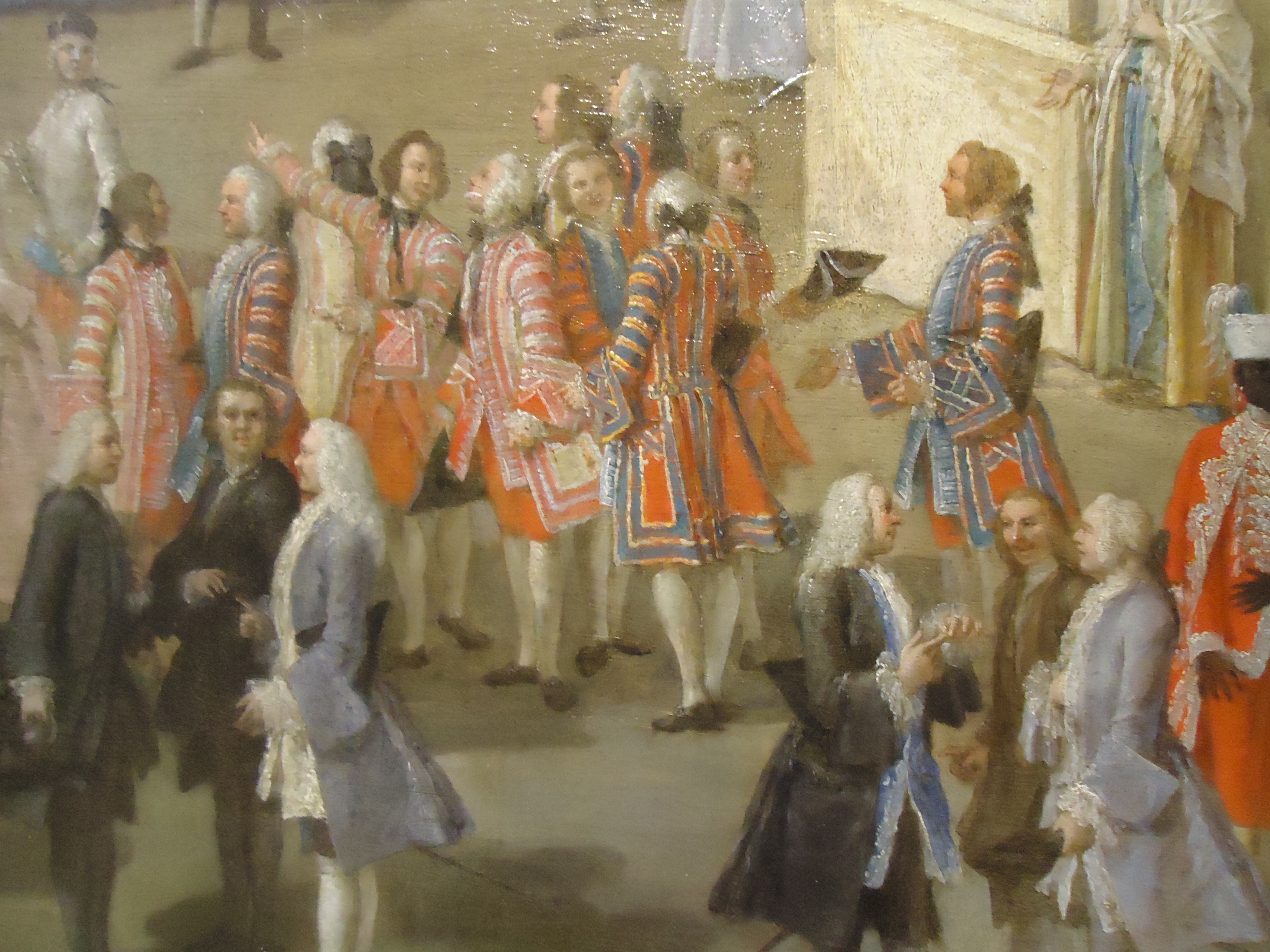
Image no.4
Here again you have several views of fashionable men and the details that were in particular fashion at the time. According to several fashion historians, men were almost trying to match their ladies wide dresses with the width and fullness of their coat skirts. These could even have wire in them to make the spring out sharply. Details that were in particular fashion were:
- Wide Deep Cuffs on the Sleeves
- The body of the jackets were still fairly baggy and had not reached the very fitted neatness of the coming decades
- Full skirts with heavily pleated vents - possible wire for shape.
- Thin, napier style swords, sticking out under the skirts of the coat.
- Tended to be collarless
- Long Waistcoats
- This is also the period when stockings start getting worn under the breeches, However the front left man seems to have his folded over the top, perhaps the fashion was a bit later in reaching Italy.
Image no.5
Details:
- Ok, well for starters there's another example of a Bag wig right at the bottom of the image and in the centre.
- We also have a lady in Pale blue wearing a style of cap very similar to Mary Edwards on the
Hogarth: An Aid to Comparison page. We don't really know if this is a specific cap or just a specific way of wearing what looks like a Mob cap with lace on it which gives it this indentation at the CF of the head. Perhaps it's more deeply frilled than later examples.
- She is also sporting a fine pair of Wing cuffs and large lace ruffles.
- The gentleman with her is mostly hidden by the way but wears a slightly deeper blue and the same sort of wig featuring in other areas of this painting.
- The working men coming through the archway behind them are mostly in dull colours which is very typical for their status. The one bent over double with his carriage is wearing fairly light coloured Stockings and ironically appear to be tucked in. He was obviously a bit of a Dandy at heart or it was more of a practical arrangement for working men to have their stockings tucked in. he also appears to be in just a shirt and wears a long functional apron.
- His friend is dressed similar but with what looks like a round hat shaped to look like a Tri-corne. We may be wrong in this.
- The ladies coming behind in the corridor, although blurred, are all in fashionable colours, yellow, light ivory and the pale to mid shade of Blue.

Image no.6
Details:
- The front two guards are both wearing their stockings folded over their breeches. They wear Tricorne hats and the blue and red uniform that features very highly in this painting. We wonder, is that because it is a Scottish colouring or Roman?
- The lady and gentleman coming out of the archway both wear pale blue, although the gentleman is wearing his with a brown jacket and brown breeches. The lady has an Echelle detail (french for ladder and which describes that bows placed down over the stomacher in a ladder formation).
- the lady in the bottom front with the guards has her fan out and again it representing the fashionable colours of pale blue and white/ivory. She is also wearing that same cap with the CF indentation. As is the lady in the middle.
- The lady with her back turned to us at the back, in pale pink is also wearing a female version of a Bag Wig and is in a Robe a l'Anglais. She has deep Wing cuffs.
Image no.7
Details:
- Drum roll please because here stands before us the two key figures this whole painting is created for. James III stands in a pale blue silk 3 piece suit. He has fairly baggy sleeves and a large, broad cuff with wing detail at the side. The cuff has covered buttons along the top.
- The skirts of his jacket stand out sharply and have pleated vents.
- His waistcoat is long and broad and buttoned down to just above the pockets flaps. His breeches don't tell us much, the interesting bits are hidden by his stockings which are folded neatly and quite deeply over them. He has a pale blue garter round his left leg. He has full white lace ruffles sprouting beneath his cuffs and he wears the blue sash of the Garter and the Star. He wears black shoes with buckles. He also carries his black tricorne hat under his arm and wears a long white wig (Possibly a Full Bottom wig - but we're not too hot on wigs!)
- Henry Benedict is apparantly in an outfit that Cardinals often wore when not in their full robes. Interestingly he has red stockings and the cardinal's red cap.
- All the soldiers behind them have stockings over their breeches. and garters holding them up.
- There's a lady in the background holding up her fan who is wearing a pale blue sack with the wide hips. We love seeing these dresses in paintings, looking so contrastingly normal and yet so strange to our eye.

Image no.8
Details:
- This is probably, for us at any rate, the most exciting close-up. We love this lady with her skirt all caught up.
- WHITE DRESS:
- First off we love the fabric, secondly it's interesting how hard and stiff looking her petticoat looks and makes us wonder if this is less a 'caned underskirt Hoop' and more a caned actual petticoat - except for the fact that she has no lines going across the fabric but that could just be the painting's fault. We know from Norah Waugh's research that the boned underskirts could be made from dress materials and were designed to be part of the ensemble and not just a hidden canvas hoop, especially, it seems early on. However as we cannot tell it's nothing but an interesting point.
- She wears white stockings and light coloured shoes.
- Her sack is also of the really loose early versions, though it does not look too wide at the neckline it is certainly is less controlled than the later examples.
- YELLOW DRESS:
- The colour of the day it appears. The Cunningtons quote from an article written in 1744 that 'Her gown and petticoat which were yellow, the colour so much the mode in England at present.'
- She too appears to be in pannier (wide side hoops) but as she is facing us as a side angle it's a little harder to tell. It is a Robe a la Francais or a 'Sack Back'.
- She appears to have a white lace/furbelow/fabric twisted neck decoration which seemed to be quite a popular trend during this period. The lady to the left in 'A Taste of the High Life' is wearing one although we're sure we can find a better example than this black and white engraving - bare with us on this one.
- She also has cuffed sleeves that aren't too big, a hair decoration in blue adn her own hair colour.
- LADY IN BLUE (far left)
- Even though we only get a small glimpse of this lady, her gown is quite striking. It's quite a strong blue, it's an Anglais (Robe a l'Anglais) and is decorated over the front Stomacher with red bows in the 'Echelle' formation.
- She has fairly deep and prominent Cuffs and is wearing her own hair.
- Her skirt also appears to be 'polonaised' slightly, although we use this term lightly: the true polonaise didn't come in til the 70s but dresses from way before this could be 'polonaised' or 'pulled up' by either drawing the end of the skirts through the pockets holes or having ties in the actual dress.
- BROWN SKIRTS OF JACKET (far left)
- We're only even mentioning this guy because it is such a clear example of how exaggerated men's jacket's skirts could get with the wire and stiffening made for them. It has been pointed out that they were trying to keep up with the women's wide dresses. - oh and he wears white stockings.
- MAN IN BLUE SILK:
- This gentleman wears a white wig, has a white cravat and a matching suit by the look of things. It is possible that his waistcoat is a tad darker in colour
-He has a collarless jacket, deep-ish boot cuffs and lace/lawn ruffles at his wrists.
- The Soldiers beyond them all wear black tricorne hats with silver braiding, white stockings and pig tails wigs of various tones.

Image no.9
Details:
- In this image we can see the lady in the mid blue dress again and a bit better and she appears to have some sort of white thing hanging down her back neck. She also wears a pearl necklace.
- The soldier holing the silver platter wears an example of the bag wig whose black ribbon also tied around to the front of the neck. Iris Brooke observes that this could have been the start of the bow tie.
- It's hard to tell sometimes if a cap is an Mob cap or a Pinner as the main difference was that the Pinner was less shaped about the crown whist the Mob had the 'puffed out crown' - Cunningtons. In their book: Handbook of English Costume in the 18th Century, the Cunningtons do mention that Pinners were narrow about the forehead. We could then class the frilled 'Head' (contemporary term for any form of head dress) on both Mary Edwards on the
Hogarth page and seen above here in many of the images as Pinners as they have that centre indent, except the fact that one of Hogarth's servants wears a Mob Cap and she has a fairly narrow bit about the forehead that could be recognised as an 'indent'. It seems it's gonna have to be one of those 'more research needed' subjects. The lady in the very light pink could be wearing either of these. Where as both ladies in blue have some sort of small Pinner attached right at the top of the crown and both with a flower or a ribbon of colour.
- Both back ladies have frills about their neckline whilst the lady in the mid blue seems to have none.
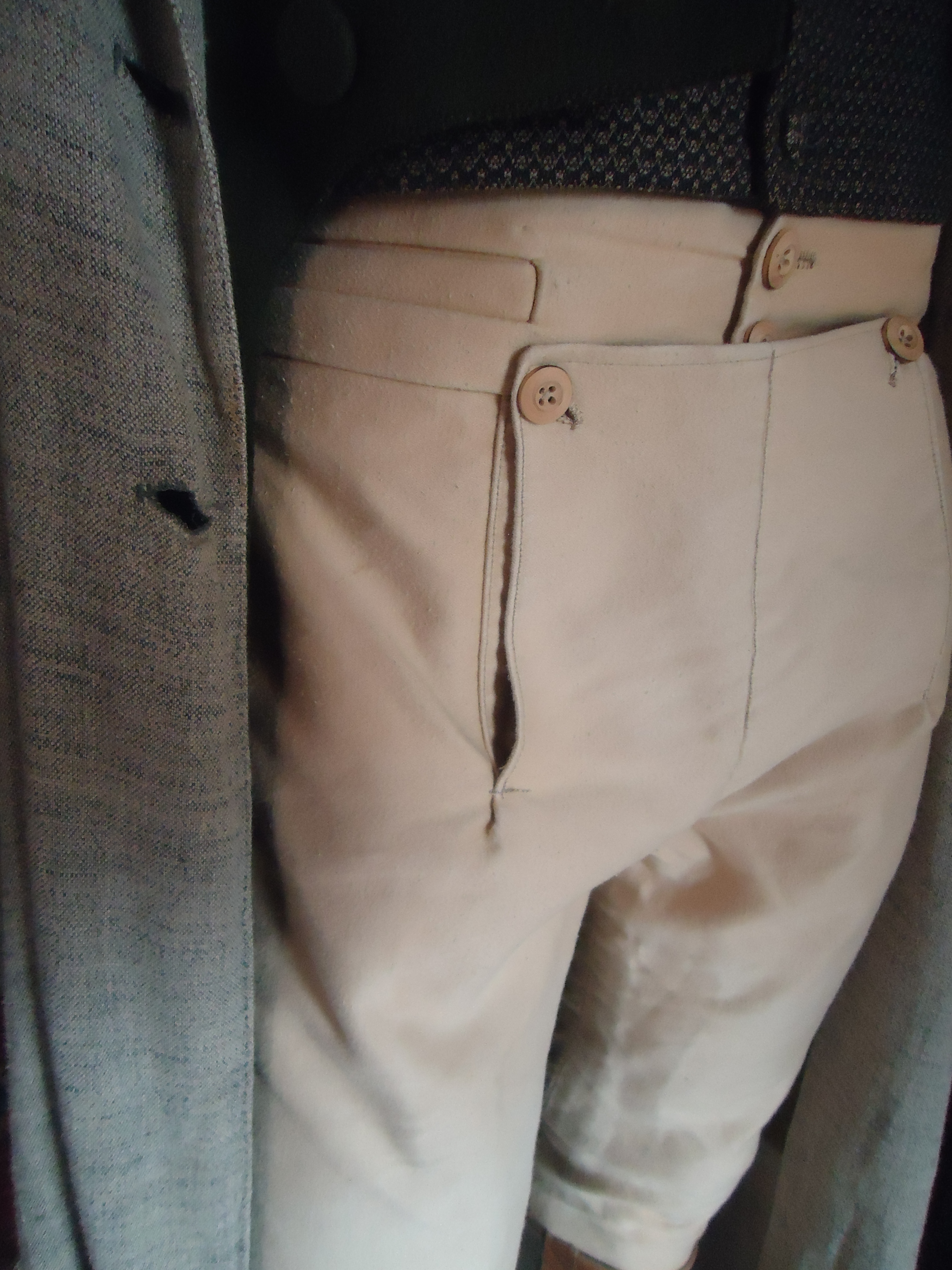 We're just beginning to research 18th century breeches to a deeper level so seeing these was quite interesting. They seem beautifully made and it would have been lovely to be able to have a look at the inside detail of the Waistband Welt Pkt. Having sampled a pair of breeches, as usual, loads of questions cropped up - therefore it is interesting to see another persons interpretation of an original garment. Their Welt sits indented in with top-stitching around the pkt on the waistband. We've copied the basic pattern from a pair in the Bath Fashion Musuem Collection and our sample had the welt pocket sitting out on top of the fabric as on a jacket. It's highlighted the possibility that either there were two ways of putting in a pocket or the fashion and technique had changed in the 50 years from our breeches to the ones this reproduction was based on. On our blog we have a whole page
We're just beginning to research 18th century breeches to a deeper level so seeing these was quite interesting. They seem beautifully made and it would have been lovely to be able to have a look at the inside detail of the Waistband Welt Pkt. Having sampled a pair of breeches, as usual, loads of questions cropped up - therefore it is interesting to see another persons interpretation of an original garment. Their Welt sits indented in with top-stitching around the pkt on the waistband. We've copied the basic pattern from a pair in the Bath Fashion Musuem Collection and our sample had the welt pocket sitting out on top of the fabric as on a jacket. It's highlighted the possibility that either there were two ways of putting in a pocket or the fashion and technique had changed in the 50 years from our breeches to the ones this reproduction was based on. On our blog we have a whole page
